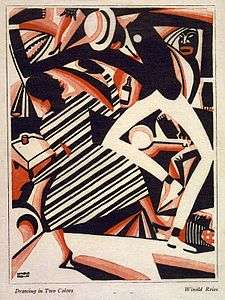Winold Reiss
F. Winold Reiss (September 16, 1886 – August 23, 1953) was a German-born American artist and graphic designer. He was born in Karlsruhe, Germany, the second son of Fritz Reiss (1857–1914) who was a well-known landscape artist. Reiss was a portraitist and his philosophy was that an artist must travel to find the most interesting subjects.
Biography

In his early years he traveled within Germany with his father who studied peasants of particular types that he wanted to draw or paint. This helped form many of Reiss' ideas about subject matter for portraiture.
Reiss immigrated to America in 1913 and was captivated by Native Americans. It was an interest and subject matter throughout his entire career. He was a success very early, lecturing before the Art Students League and even founding a publication, Modern Art Collector. He made over 250 paintings of Native Americans, especially the Blackfeet.[1]
Reiss returned once to Germany in 1921 but only as a visit; coming once again to New York City in 1922.
Reiss also illustrated Alain Locke's The New Negro, an important book about African American culture.
His most outstanding commission was for the work performed on the Cincinnati Union Terminal (now known as the Cincinnati Museum Center) in 1933. He blended Art Deco with portraiture which captured the history of Cincinnati through its people. Fourteen murals from the passenger concourse were removed to the Cincinnati/Northern Kentucky International Airport in 1973. With the concourses they are in scheduled to be demolished, nine of the murals are being moved to the Cincinnati Convention Center at a cost of $1.4 million.[2] [3]
Winold Reiss was a leader who devoted most of his life towards painting a much broader cross section of ethnic diversity in America, in a compassionate and objective manner, than any artist before him.
He died on August 29, 1953 in New York City. The Blackfeet spread his ashes along the eastern edge of Glacier National Park.[1]
Architecture
His interior designs were influenced by the Vienna Secession. The lightness of style, use of grids, and gilded and highly colored panels echo more the Wiener Werkstätte of Vienna than the Jugendstil of Munich. His design for the Busy Lady Baking Company on 3620 Broadway (at 149th Street), and one at 4230 Broadway in 1915 was very similar to the designs of Josef Hoffmann and the Wiener Werkstätte. Viewing the development of Reiss's work through the various decades helps to establish the fact that the floral abstractions of the 1930s and the sparse geometry of the 1940s are coming directly from his early experience. His commissions were important ones and had an influence on American design and architecture.
Another of his noted interior designs was the Café Rumpelmayer in the Hotel St. Moritz in the 1930s.
Family
His son, Winold Tjark Reiss (born in Germany on December 27, 1913 – 2001) studied at the Massachusetts Institute of Technology and in Vienna, becoming an architect and working in the United States. He established the Reiss Partnership in 1996 to create a vehicle for fostering awareness of his father’s artistic legacy and to make it accessible to a broad public.
Gallery
 Drawing in two colors
Drawing in two colors
(between 1915 and 1920) Steel workers
Steel workers
(ca. 1920) Cover proposal for Fortune magazine (between 1930 and 1940)
Cover proposal for Fortune magazine (between 1930 and 1940) portrait of Langston Hughes (1927)
portrait of Langston Hughes (1927)
References
- 1 2 Tribune Staff. "125 Montana Newsmakers: F. Winold Reiss". Great Falls Tribune. Retrieved August 25, 2011.
- ↑ http://www.bizjournals.com/cincinnati/news/2015/05/20/cvgs-huge-historic-murals-are-coming-to-downtown.html
- ↑ Radel, Cliff. "Rookwood's kiln master identified". cincinnati.com/. Retrieved 24 June 2013.
- Winold Reiss 1886-1953. Centennial Exhibition. Works on paper: Architectural Designs, Fantasies and Portraits. 21 East 84th Street, New York, NY 10028: Shepherd Gallery, Associates. November 19, 1986 – January 3, 1987.
External links
![]() Media related to Winold Reiss at Wikimedia Commons
Media related to Winold Reiss at Wikimedia Commons